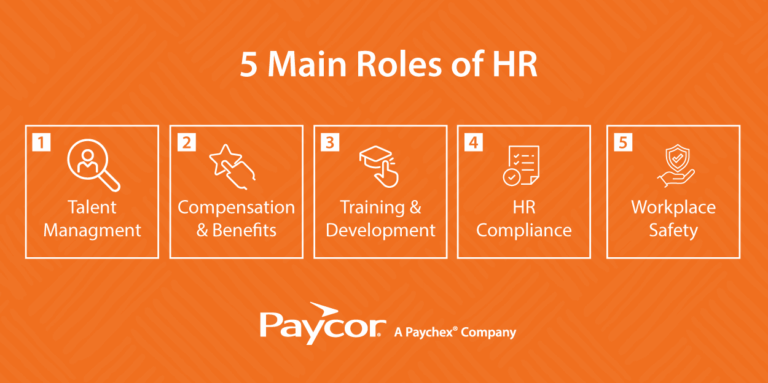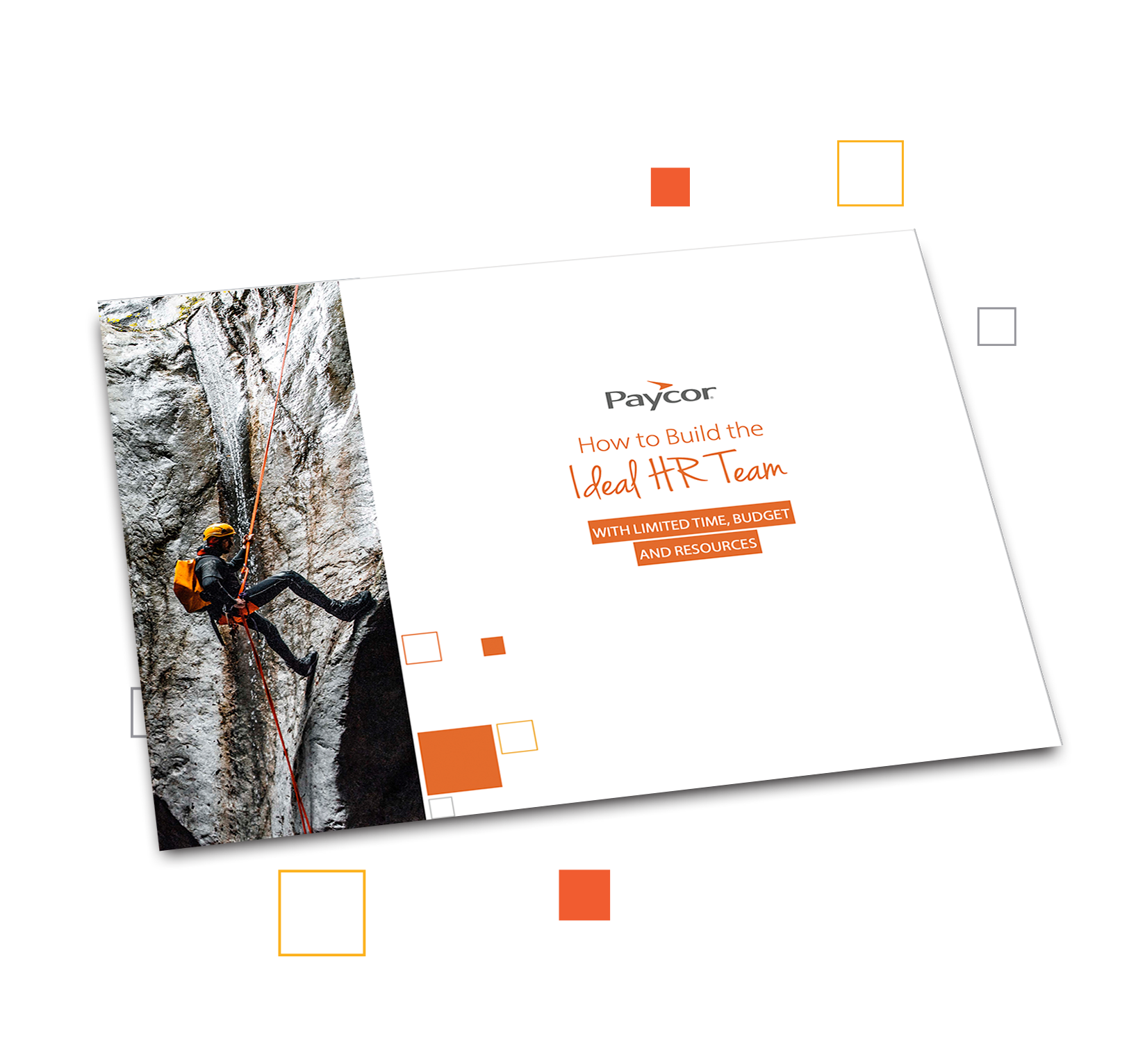An effective human resources (HR) department is a key part of business success. This team is responsible for your most valuable asset: your people. A lot of HR’s responsibilities are invisible — especially if done well. And in smaller companies, one person might take on several HR roles. In this article, we’ll explore the top five duties of this department, and what an HR team needs to be successful.
What is Human Resources (HR)?
Human Resources (HR) is division of a business responsible for managing the employee lifecycle — from hiring and onboarding to training, performance management, and offboarding. An HR department and team helps ensure a company complies with labor laws, fosters a positive workplace culture, and supports both employee needs and business goals.
What Does HR Do?
HR oversees the systems, policies, and practices that shape the employee experience and workforce performance. At a broad level, HR functions include recruiting talent, administering benefits, managing employee relations, ensuring legal compliance, and supporting professional development. These efforts align people strategy with business strategy, enabling the organization to attract, retain, and develop a high-performing workforce.
Main Roles of HR (Responsibilities, Duties, and Skills)

The roles and responsibilities of HR can be categorized into five main categories. They include:
1. Talent Management

Talent management encompasses sourcing, hiring, developing, and retaining employees. It combines people skills with strategic planning, workforce analytics, and a deep understanding of company culture. Here’s a closer look at human resources’ responsibilities when it comes to talent management.
Develop Talent Acquisition Strategy
HR works closely with department leaders to identify workforce gaps, define ideal candidate profiles, and build hiring timelines. They also determine competitive compensation benchmarks and recruiting budgets. A strong talent acquisition strategy helps ensure the company hires the right people at the right time.
Recruit Candidates
Effective recruitment requires collaboration with department managers to understand hiring needs. In addition, HR is often responsible for crafting job postings and promoting them across relevant channels. They also screen resumes, conduct initial interviews, and coordinate the hiring process across teams
Hire Employees
After selecting a candidate, HR steps in to finalize the hire and ensure a smooth transition into the company. This includes running background checks, extending the offer, handling any negotiations, and guiding the employee through onboarding. HR also sets up the necessary tools and training so new hires feel prepared and supported from day one.
Retain and Engage Employees
Retention efforts focus on building a workplace where employees want to stay. HR teams improve engagement through recognition programs, growth opportunities, performance reviews, and communication strategies. They may also handle employee relations, satisfaction surveys, and conflict resolution to maintain a positive work environment.
2. Compensation and Benefits

Fair pay, competitive benefits, and reliable payroll helps attract and retain the best talent.
Conduct Salary Benchmarking
To stay competitive, HR evaluates compensation data across the industry and builds structured pay ranges based on role, location, and experience. Salary benchmarking helps companies offer attractive packages while maintaining internal equity and budgeting effectively.
Benefits Management
Think of benefits as a long-term retention strategy. Strong offerings help attract top talent and keep current employees engaged. HR manages the day-to-day administration of these perks, from negotiating with insurance providers to coordinating with 401(k) plan administrators. They also communicate benefits clearly to employees and assist during enrollment periods.
Payroll
HR is responsible for ensuring payroll is issued accurately and on time. HR professionals work closely with finance or dedicated payroll staff to track hours, calculate deductions, file taxes, and handle wage-related questions. A well-run payroll process builds employee trust and protects the company from costly errors or penalties.
3. Training and Development

Every leader wants to see their employees thrive. That means providing them with all the tools they need to succeed. Training and development (sometimes called learning and development) is integral to any HR strategy. The category includes:
Oversee Training
HR coordinates training programs that equip employees with the knowledge and skills they need to succeed. This includes onboarding for new hires, compliance training, and technical upskilling. HR may also track participation and progress to ensure the training meets individual and organizational goals.
Provide Professional Development
HR helps employees expand their capabilities through workshops, mentorships, certifications, and tuition assistance. These opportunities not only enhance performance, but also show employees they’re valued.
Assist Employees
From setting learning goals to navigating career paths, HR supports employees throughout their development journey. Whether it’s helping someone transition into a new role or coaching them through a challenge, HR acts as a strategic partner in employee growth.
4. HR Compliance

Legal and regulatory compliance is a critical component of any HR department. Employment and labor laws are extremely complex, and they’re always changing. Without a dedicated compliance team, your company can face hefty fees or even legal consequences.
Ensure Labor and Tax Law Compliance
To keep a company compliant, HR needs to stay apprised of federal and state laws, upcoming regulatory changes, and relevant reporting deadlines. You’ll also need a way to evaluate your labor practices. The compliance team should fully understand employment laws like the Fair Labor Standards Act (FLSA), the Family Medical Leave Act (FMLA), Title VII of the Civil Rights Act of 1964, the National Labor Relations Act of 1935, and dozens of other rules and regulations.
Update Policies
The HR compliance team plays a major role in crafting and updating the employee handbook. This requires collaboration with other HR managers, the C-Suite, and other stakeholders from across the company.
Manage Employee Documentation
Accurate, secure recordkeeping is essential to compliance. HR is responsible for maintaining personnel files, I-9 verification forms, tax documents, performance records, and disciplinary actions. These records must be stored in accordance with legal retention requirements and made accessible during audits or legal reviews. Proper documentation also protects the company in cases of disputes or investigations.
5. Workplace Safety

Under the Occupational Safety and Health Act of 1970 (OSHA), employers must maintain safe working conditions. HR professionals support compliance, guide behavioral expectations, and foster a culture where employees feel both physically safe and psychologically supported.
Create a Safe Work Environment
HR helps implement and enforce safety protocols to protect employees from physical harm. This includes facilitating safety training, logging workplace incidents, reporting issues to regulatory agencies, and coordinating with benefits specialists on workers’ compensation claims. A proactive approach to safety reduces risk and shows employees their well-being is a priority.
Conduct Disciplinary Actions
When workplace conduct violates policy or creates an unsafe environment, HR is responsible for addressing the behavior. This may involve issuing warnings, facilitating corrective action plans, or initiating termination processes when necessary. By handling these situations consistently and fairly, HR helps maintain a respectful and accountable workplace.
Manage Employee Belonging Efforts
Safety isn’t just physical — it’s also emotional and psychological. HR teams lead efforts to ensure every employee feels respected, included, and valued. This includes managing diversity, equity, inclusion, and belonging (DEIB) initiatives, responding to workplace concerns, and cultivating a culture where people can thrive without fear of bias, harassment, or exclusion.
How Does HR Support Employees?
The threaded link through all of the roles of human resources listed above is providing support to employees. HR teams offers support in the following ways:
Providing Career Paths
HR works with managers and employees to map out clear, achievable career trajectories. This might include establishing promotion criteria, identifying skills gaps, and offering mentorship opportunities. When employees understand their growth potential, they’re more motivated to stay and contribute to the organization’s success.
Offering Continuing Education Opportunities
To foster long-term development, HR often coordinates learning opportunities, such as workshops, certification programs, or tuition assistance. Supporting lifelong learning empowers employees to stay competitive in their fields, which in turn helps the business keep up with evolving industry standards.
Training Managers
HR equips people leaders with the tools they need to lead effectively. This includes management training on communication, performance reviews, conflict resolution, and inclusive leadership. Well-trained managers are essential to shaping a healthy and productive workplace.
Encouraging Health and Wellness
HR also plays a key role in supporting employees’ physical, mental, and emotional health. From organizing wellness programs and promoting employee assistance plans to offering flexible work arrangements, HR helps foster a workplace where people feel cared for both on and off the clock.
How Paycor Helps with HR Responsibilities and Duties
There’s a lot of crossover between the five main HR functions. Even for a skilled team, it can be hard to manage all these moving pieces. But the success of your business depends on their work. Leaders can streamline every aspect of HR by giving these teams the tools they need to succeed.
Paycor’s suite of HR software is purpose-built for leaders. Our tools empower you to support every stage of the employee life cycle, from hire to retire.
Use Paycor for the Roles of HR
While HR department roles each require a human touch, there are many aspects that can be streamlined or automated so HR professionals can focus more on strategy. Ready to see how Paycor HCM software can level up your HR operations? Take a guided product tour.

How to Build the Ideal HR Team (with Limited Time, Budget & Resources)
Leaders building an HR team need a good framework in place. Download our guide to learn how to build a great team.









